Aspen's Local Summer Confabs Reach an All-Time High
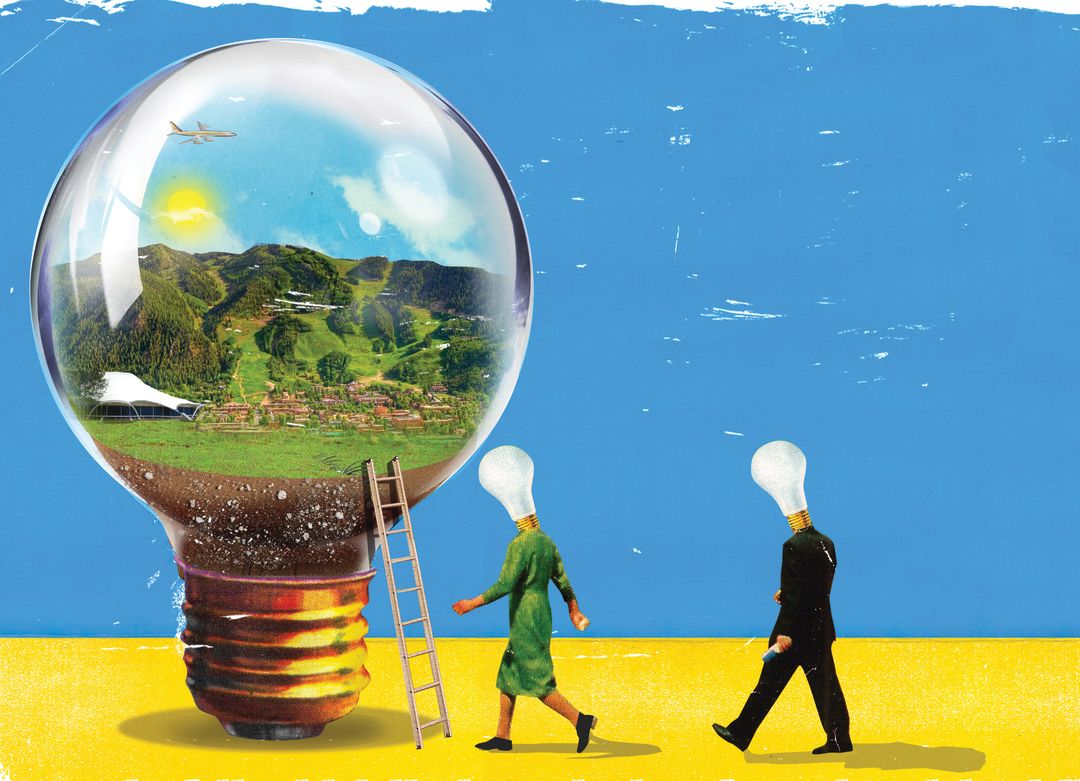
Image: Matthew Billington
On a high-mountain day worthy of a calendar photo—the sky an absorbing blue, the Roaring Fork River still hurrying with snowmelt—I listened as Tom Steyer held forth last summer in the Benedict Music Tent on the campus of the Aspen Institute. I had come to the 2015 Aspen Ideas Festival to witness firsthand one of the town’s premier talk-oriented gatherings. Onstage, dressed in white pants and a checkered shirt, the sandy-haired Steyer was inveighing about the problem of climate change and the need to decrease our dependency on atmosphere-polluting fossil fuels.
A billionaire, Steyer has become an activist of consequence since retiring from Farallon Capital Management, the hedge fund he founded in 1986. Through what one magazine described as a “green super PAC,” Steyer spent $74 million in the 2014 midterm elections in an effort to elect or reelect Congressional candidates who shared his concern about climate change. Now, speaking at the 2015 Aspen Ideas Festival, the California-based Steyer expounded knowledgeably for an hour about the intersection of technology, markets, and public policy in reducing greenhouse-gas emissions. The most captivating question, though, came last.
“We do have a remarkable situation,” said his interrogator, Ronald Brownstein, editorial director for strategic partnerships at Atlantic Media, a cosponsor of the Aspen Ideas Festival since its inception in 2005. “In the front row, we have David Koch and here you, who are seen as opposite poles in this debate.” Where, Brownstein wanted to know, was the common ground?
Somewhere in the spirit world, long-departed Walter Paepcke may have curled a tight smile. This was exactly the sort of exchange that Paepcke had envisioned in those early years after World War II when he arrived in town with plans to mold Aspen’s postmining identity. There was ski season, of course, but guided by Paepcke’s checkbook, connections, and interest in commerce and culture, Aspen in summer became, in the words of one writer at the time, a “spa for the brain.”
Since then, talk about big ideas has always been a part of Aspen summers. Occasionally, that talk has had immediate international consequence. In 1990, it just so happened that both President George H.W. Bush and British Prime Minister Margaret Thatcher were in Aspen soon after Saddam Hussein’s Iraqi troops invaded Kuwait. “Remember, George, this is no time to go wobbly,” Thatcher told Bush, a highly decorated combat veteran from World War II. Bush took steps soon afterward that led to Operation Desert Storm.
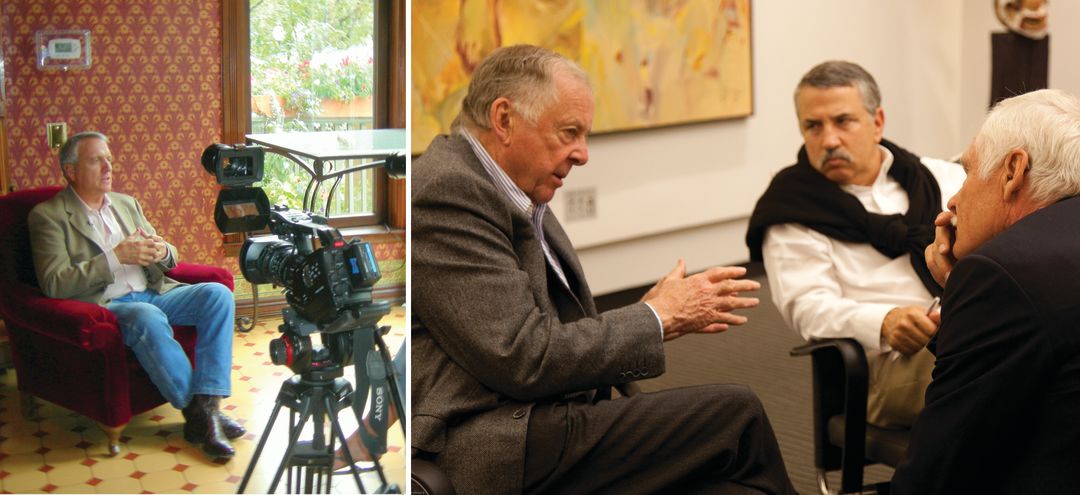
Right: T. Boone Pickens, Thomas Friedman, and Ted Turner convened at AREDAY in 2010. Left: Former Colorado governor Bill Ritter, now director of the Center for the New Energy Economy at Colorado State University, has been a frequent presenter at AREDAY.
Image: Jeanette Darnauer and Vance Howard
Ski season in Aspen typically lasts 120 to 130 days. Summer talk season runs about the same length of time, from mid-June into October. It’s like TED talks taking place on an almost daily basis—except at the Aspen confabs you can ask questions.
Some are open to the public; some aren’t. Some of them, such as the annual migration of high-level scientists to the Aspen Physics Center, have been going on for decades. But in the past 10 years, the pace of talk about weighty issues of the world has accelerated. Foremost among the newer conferences is the Aspen Ideas Festival.
Walter Isaacson was integral to its creation after he became president and CEO of the Aspen Institute in 2003. The institute had been holding several dozen public-policy conferences each year, but they tended to be off-the-record, invitation-only affairs, and Isaacson wanted more public engagement.
With the world as its oyster and the well-heeled Aspen Institute to execute the conference, Ideas Fest, as it’s known informally, had immediate breadth and depth. There were newspaper columnists from Washington, D.C., and New York, philanthropists and former presidents, environmentalists and economists, musicians and muckrakers, artists and authors, biologists and bandleaders, foodies and fiscal leaders … the list goes on. Now the festival showcases 350 speakers each summer, spread across 10 days and with 3,000 people in attendance.
In the tradition of Paepcke’s seminal conference in 1949 honoring the birthday bicentennial of Johann Wolfgang von Goethe, Ideas Fest was and is designed to be pluralistic. Competing ideas are solicited and sometimes paired. If environmentalists get the microphone, so do executives from the timber and auto industries. The intent is to create a “moderated, controlled dialogue” that seeks to deliver a “little better understanding of adversaries’ positions,” says Jim Spiegelman, vice president and chief external affairs officer for the institute. “That really is our stock-in-trade. We want to manage the dialogue to see if we can find common ground.”
Hence the presence, on that afternoon last summer, of both Tom Steyer and David Koch. Koch and his brother Charles have been swinging their big, billionaire bats in U.S. elections, aiming for deep right field. Their candidates typically deny the risk from human-caused climate change. What did Steyer see as his common ground with the Koch brothers? A belief, said Steyer, that once a problem has been identified, the free market is very efficient at allocating capital. “We don’t have to agree on the policies. We have to agree on the problem,” he said on that day in the tent last year. “I believe we will end up pulling on the same oar.” Afterward, Steyer and David Koch shook hands and, reportedly, agreed to meet over coffee. (Whether they found common ground over coffee grounds could not be ascertained.)
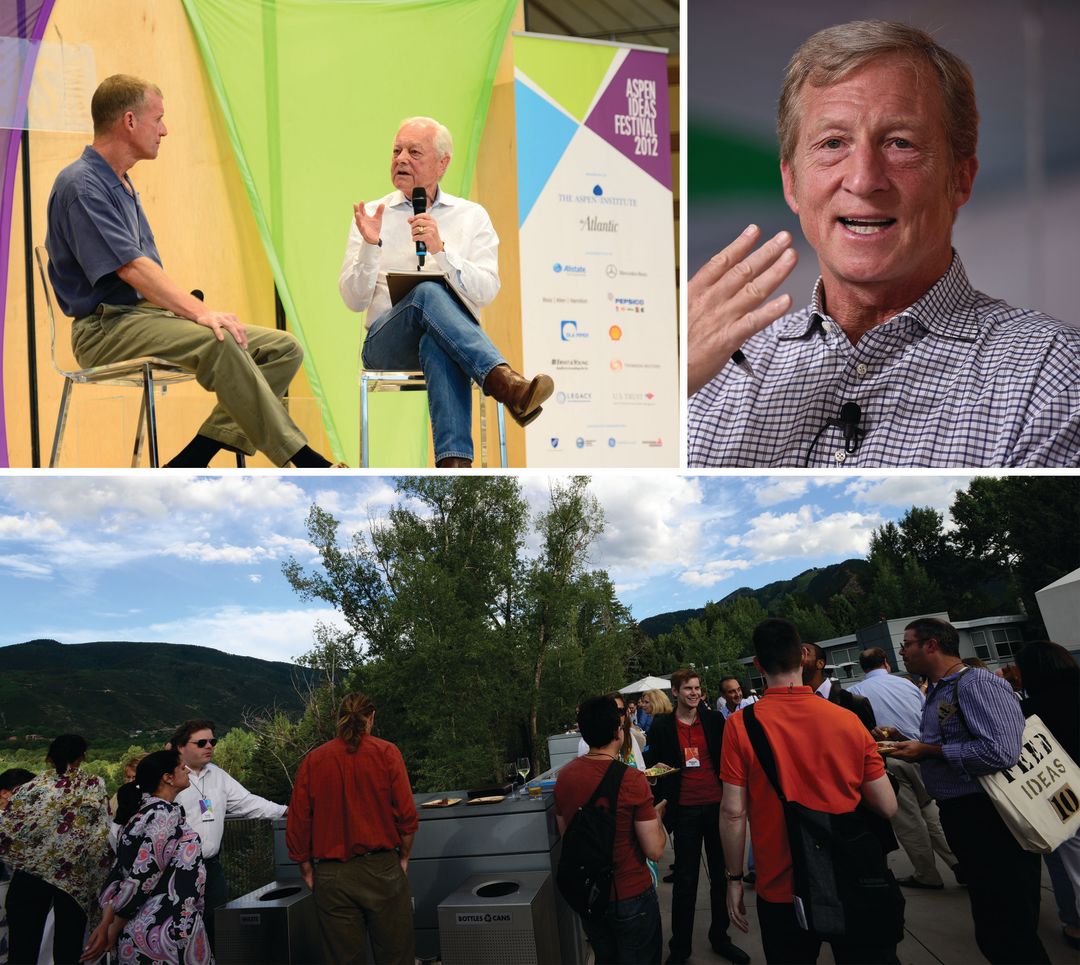
Clockwise from left: Ideas Fest attendees; Gen. Stanley McChrystal being interviewed by CBS’s Bob Schieffer at the 2012 Aspen Ideas Festival; climate-change activitist Tom Steyer at Ideas Fest in 2015.
Image: Dan Bayer, Aspen Institute, and Riccardo Savi
Another conference, at first decidedly humble and homegrown, was birthed in 2004. Called Aspen Renewable Energy Day, it featured a few local speakers and an exhibit of solar panels. The founder, Chip Comins, had arrived in Aspen in the late 1970s to ski and, because he needed to work, wash dishes. He later dished out oysters at Aspen restaurants and created a phone service before eventually becoming a filmmaker. His work in documenting wind farms on the Great Plains inspired him to create a conference revolving around climate change.
The event slowly gained muscle. The next year, local energy guru Amory Lovins, former U.S. Sen. Gary Hart, and the late Randy Udall spoke in an evening session at Paepcke Auditorium. By 2010, the confab had come into its own. Ted Turner has spoken five times, T. Boone Pickens four times, and New York Times columnist Thomas Friedman three times. Tom Steyer has spoken twice at what is now called American Renewable Energy Day. But not David Koch, who has a home in Aspen. “I don’t know if I could get him. If I could, I would,” says Comins.
Speakers return year after year, says Comins, because “they get to take their latest findings and present it to their peers,” he says. “So even though it’s open to the public, this really is a speakers’ summit of collaboration and strategic partnerships.”
At last summer’s conference, former Australian prime minister Kevin Rudd talked about his country’s adoption of a carbon tax. Former U.S. Sen. Tim Wirth—who helped make climate change part of the U.S. conversation with his carefully staged Senate hearings in 1988—laid out why the Paris climate negotiations were almost certain to be a success. Tony Seba, a lecturer at Stanford University, explained why market disruption with clean energy could happen quickly (“Does anybody know what a typewriter is?” he asked). And midway through the third day came this announcement: two attendees, in a hallway conversation, had agreed to an entrepreneurial clean-energy collaboration.
That’s exactly the sort of announcement that Comins says he and co–conference organizer Sally Ranney seek to foster. The goal, he says, is to draw “buyers and sellers from across the world to meet each other with their checkbooks and business plans” in what he hopes will become the “Davos of clean-energy technology.”
Not all of Aspen’s talk fests are for public consumption. For years the late billionaire and philanthropist Theodore Forstmann invited movers and shakers to an exclusive annual conference hosted by his private equity firm Forstmann Little. In addition to off-the-record sessions, the gathering of world leaders, business titans, and celebrities included outdoor recreation, parties, and private concerts at the Wheeler Opera House (the Eagles one year). Newer, but just as hush-hush, is the “Weekend with Charlie Rose,” which became very public in its second year when Vice President Joe Biden and his 40-car entourage motored through the Roaring Fork Valley on the way to Aspen, temporarily shunting traffic from Highway 82 onto secondary roads.
Some of these conferences cater to very specific audiences. The Aspen Security Forum, cosponsored by the Aspen Institute and CNN, was created in 2009 with the intent of exploring “critical questions about national and homeland security.” Speakers are a mix of correspondents and editors from major news organizations and officials with government agencies. The Resnick Aspen Action Forum emphasizes the intent of “moving from thought to action” in matters such as race, a topic at this summer’s session. Also sponsored by the Aspen Institute, it’s designed to catalyze the 350 vetted “doers” who attend into figuring out how to surmount hurdles.
Each July Fortune magazine’s Brainstorm Tech invite-only event attracts entrepreneurs, investors, and Fortune 500 CEOs for three days of networking, fast-paced panel presentations, and roundtable discussions. Last year’s agenda included sessions such as “Artificial Intelligence: When will AI change your life?” and “Hiring by Algorithm: How will analytics change HR forever?”
Could these confabs be held elsewhere? Not with the same success. In the 1940s, Paepcke understood the power of Aspen’s small-town setting and majestic mountain environment. So do conference organizers today. The Aspen Institute holds events in several major cities, “but when you bring it to a small mountain town like Aspen, it takes on a whole different feel,” says Spiegelman. “It’s not just taking a taxi, taking the elevator, and going to a room. It’s the total value, the notion of mind, body, and spirit. The majesty of the place really changes your whole perception of the experience.” Too, he points out, when speakers and attendees are all in close contact for several days, good things can happen.
Close associations in informal settings seem to produce sparks at the Aspen Center for Physics, which was created 54 years ago by Bob Craig, Michael Cohen, and George Stranahan; the latter was struggling to complete his PhD and wanted other physicists to talk with and bounce ideas off of. He understood that the science of physics was actually a very social activity.
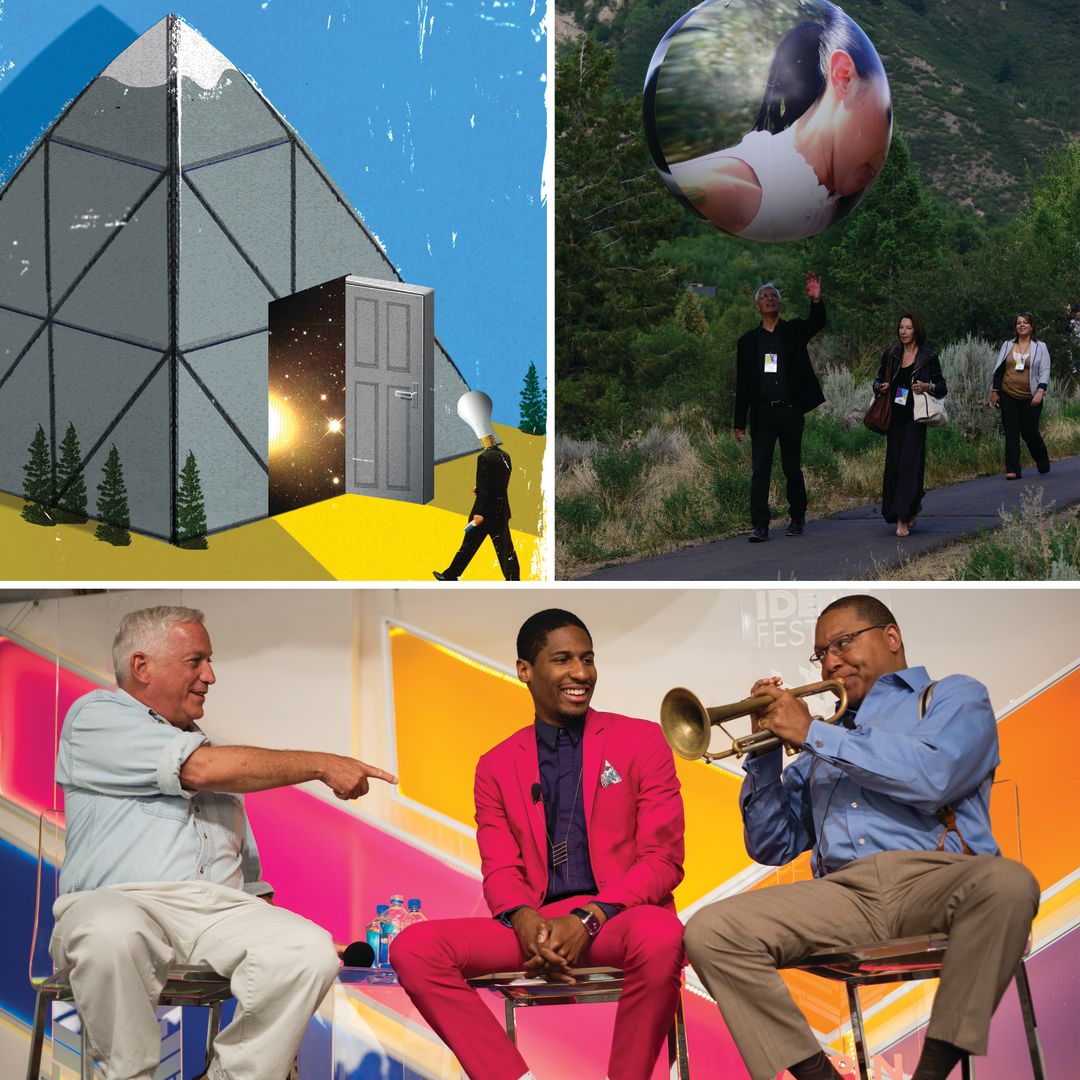
Bottom: Walter Isaacson, Jon Batiste, and Wynton Marsalis at the Aspen Ideas Festival last Fourth of July. Top Right: temporary artwork pops up around the Aspen Meadows campus during Ideas Fest.
Image: Dan Bayer
More than 50 Nobel laureates have been among the 500-plus physicists who come each summer to attend the center’s multiweek workshops, and their theoretical research underlies discoveries in every field of biophysics, astrophysics, cosmology, condensed matter, and particle physics. String theory, a theoretical attempt to unify the theory of gravity or classical physics with quantum or particle physics, was first developed in Aspen.
“One thing that struck me when I started working here was that I would hear so much laughter,” says Patricia Fox, who directs public communications for the center. In time, she understood why: “If the science is to move forward, physicists must be able to absorb the criticism to which their new ideas must submit and not feel defeated. One way to keep positive is to have a sense of humor.”
Practical considerations also play a role in Aspen’s summer talk scene. Improved air connections have arguably helped make all of this yakety-yak here possible. True, the wealthiest mostly fly in on private jets, but commercial service matters greatly, even for high-profile attendees. After Jimmy Carter spoke at AREDAY in 2014, he left for Atlanta on a commercial plane.
Not to be overlooked are population demographics, both in Aspen and, more broadly, in the United States. As Baby Boomers have moved into middle age and beyond, passions tend to shift from rigorous physical activity into the dynamics of the head. Graying hair dominates the audiences at Ideas Fest and other conferences.
Impressive as the list of conference speakers (and attendees) may be, what actually comes of all this chattering in Aspen? Sometimes, big things, like the Bush-Thatcher exchange that preceded Operation Desert Storm.
At times, the talk has morphed from innovative idea to concrete action. As Gen. Stanley McChrystal, the former U.S. commander in Afghanistan, was interviewed by CBS’s Bob Schieffer at the 2012 Ideas Fest, he shared his notion that national service should be universal. That led to the creation of the Franklin Project, which seeks to marshal a voluntary civilian counterpart to U.S. military service.
Sometimes big ideas lead to big money, says Elliot Gerson, executive vice president of the Aspen Institute. He cites an Ideas Fest lunch at which Nobel laureate physicist Murray Gell-Mann urged cancer physician and writer David Agus and others to apply for a $20 million grant from the National Institutes of Health. They applied and got the money, allowing them to study cancer as a “complex system,” as Gell-Mann had suggested.
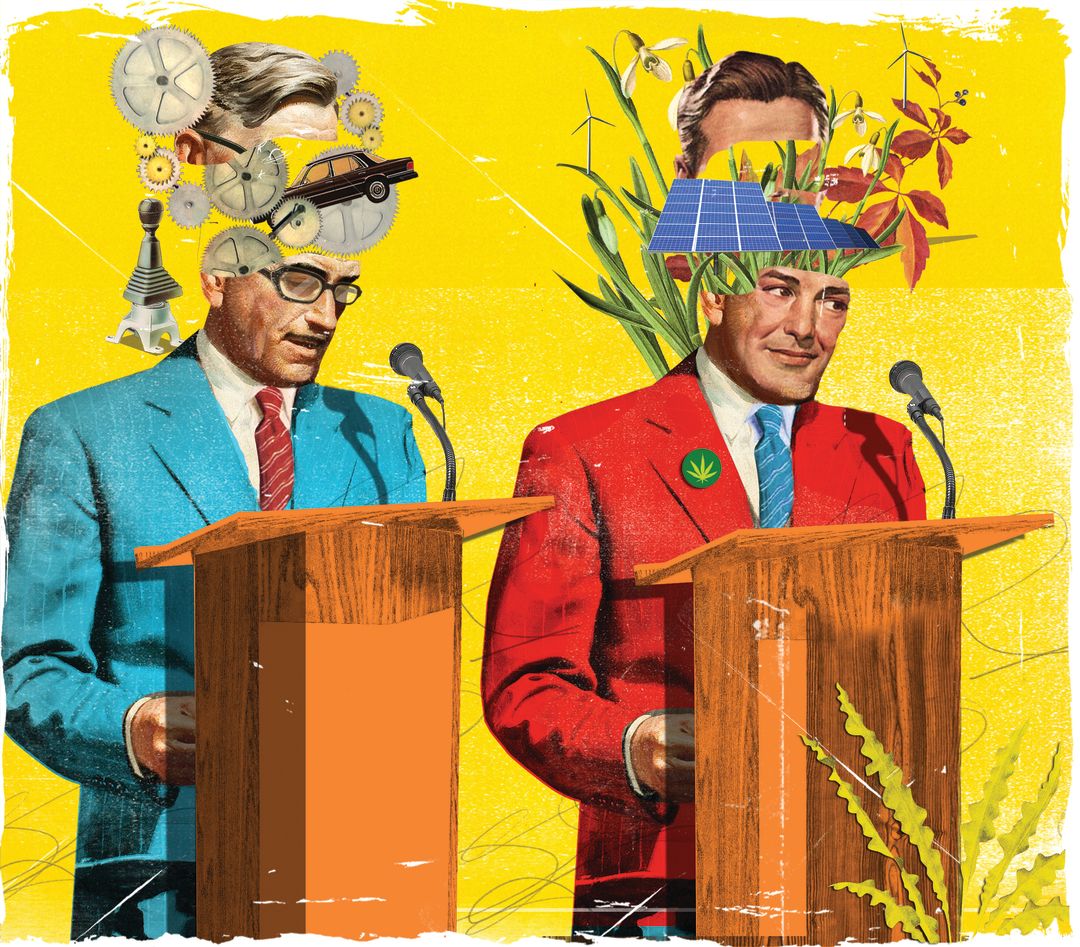
Ideas Fest organizer Kitty Boone, vice president and director for public programs of the Aspen Institute, points to a presentation of design ideas by college students one year that moved an audience member to donate $15 million to a university to start something similar. “Those kinds of things happen,” she says.
Immediate consequences, however, are not necessarily the goal of the festival, says Boone. Instead, it is to foster deeper understanding. “For somebody who has an intellectually curious appetite, these kinds of events really nurture them,” Boone asserts. “I think that’s important, because they take the ideas and share them with others.”
Smaller in scale, American Renewable Energy Day has a similar dynamic. Admits Comins, “There is a lot of stuff that comes out of AREDAY that is intangible. What we try to do is foster creative collaborations.”
Michael Bowman, a Colorado farmer and activist for renewable energy, has been at every AREDAY since 2005, save one. For him, it’s a chance to renew contacts with people of influence like Ted Turner and former Colorado governor Bill Ritter. These connections matter. Ritter, for example, heads the Center for the New Energy Economy and recently helped with installation of a 100-kilowatt solar array in Nebraska. Another connection Bowman made yielded money for a booth at the Kansas Speedway that reached 30,000 people with a message from veterans of the Middle East wars about clean, domestic energy. Those NASCAR followers would be less inclined to hear the same message from Al Gore or environmental groups, says Bowman. In this and other ways, he says, AREDAY has an impact in which “the sum of the whole is greater than the sum of the parts.”
Occasionally, a remark made here immediately becomes part of a national conversation. Such was the case in 2014 when Indra Nooyi, chairperson and CEO of PepsiCo, responded to a question at Ideas Fest on work-life balance by saying she thinks woman can’t “have it all.” On starting families, for instance, she said, “The biological clock and the career clock are in total conflict.” For a time, her comments were hotly debated in the national press.
Alternately, one of the chance encounters these confabs like to tout as a reason for being can lead to something concrete. At another session, broadcaster Katie Couric recalled the seed that was sown for the latest book by New York Times columnist David Brooks: a conversation they’d had the previous year at the Aspen airport after Ideas Fest.
Last year’s final session of Ideas Fest occurred on the Fourth of July. I watched in anticipation as a tall, young man in a hot-pink suit, a turquoise shirt, and white tennis shoes stepped on stage and sat down at the piano. It wasn’t your usual rendition of “The Star-Spangled Banner,” nor was the next song that the pianist, Jon Batiste, performed with Wynton Marsalis, a jazzy version of “America the Beautiful.” Both natives of New Orleans, the two musicians then talked with another Big Easy native, Isaacson, about the roots of jazz.
It was an electrifying hour, but then there was something more. This was just after the mass murder in Charleston, S.C., and the renewed furor over the Confederate flag atop the South Carolina statehouse. Isaacson wanted to know what Marsalis thought about the statutes in New Orleans that honored Andrew Jackson and Robert E. Lee, both also slave owners. Marsalis had an evolved answer that concluded with a simple take-home: be careful of the symbols you choose, he said, because they are powerful. His words were powerful enough that they became the ending to my annual Christmas letter to family and friends.
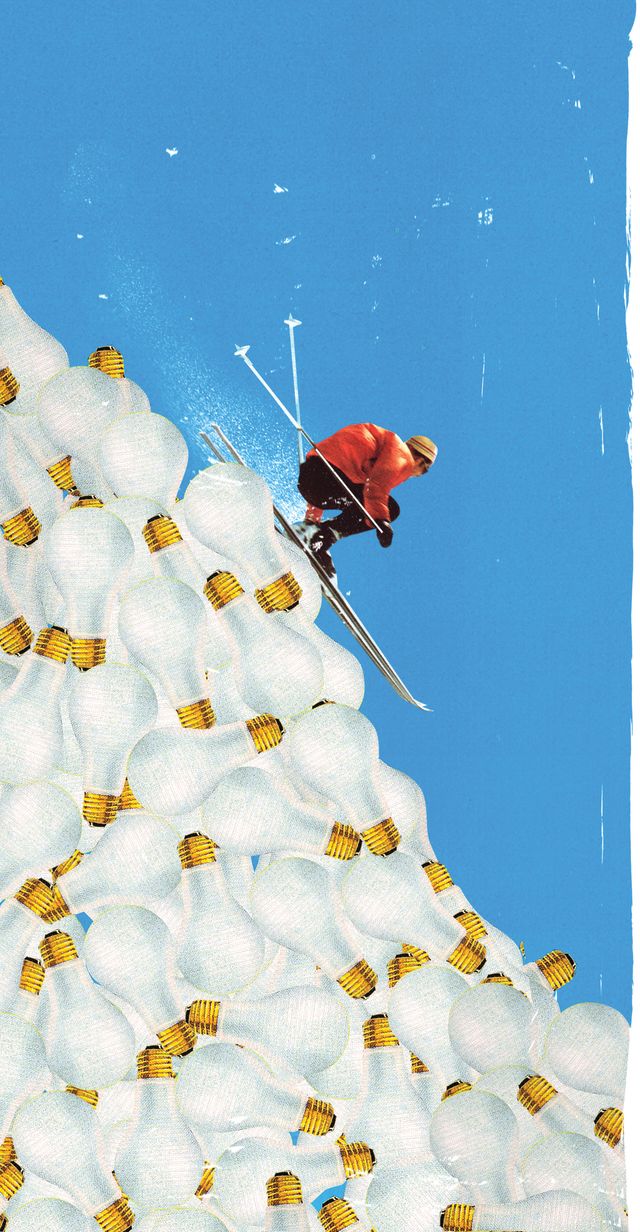
Be Mindful
Summer talk season promises plenty of insights, inspiration, and calls to action. Here, a preview of three not-to-miss gatherings.
Aspen Ideas Festival
June 23 – July 2, aspenideas.org
The motherlode of Aspen’s summer confabs, Ideas Fest draws an impressive roster of speakers, including enough VIPs to cram the tarmac at the Aspen airport with private jets—no exaggeration. Throw a presidential election into the mix, and expect discussions of hot-button issues to really sizzle this year.
The festival, which is held at the Aspen Institute as well as at various venues around town, is divvied up into three four-day sessions that include 19 program tracks among them. The second and third sessions are sold out, but, as of press time, passes were still available for the kickoff session, Spotlight Health. Public tickets to individual events during the whole festival, including five documentary film screenings at Paepcke Auditorium, go on sale June 17.
Of the program tracks, “The Choice 2016” (second and third sessions) will be devoted entirely to the presidential race, but candidate issues will also permeate other tracks, says Pherabe Kolb, the Aspen Institute’s managing director of communications and public affairs. She adds, “In an election year, there is certainly a sense of heightened urgency.”
Other buzz-worthy tracks include “The University at a Crossroads” (third session), which will address the issues currently plaguing higher education, and “Sex in America” (third session), an investigation into current sexual mores that will bring in new speakers and “viewpoints that haven’t been given center stage before,” says Kolb. “It shows that the Aspen Ideas Festival does not shy away from ideas that are controversial but central to human life and deserve the thoughtful treatment that the festival can give.”
AREDAY
June 19–24. areday.net
Last year the American Renewable Energy Institute’s annual six-day summit moved from Aspen to Snowmass Village. This year, the 13th AREDAY moves from August to June. What’s still the same: an agenda with more than 100 speakers and the aim of breaking down barriers between politicians, investors, scientists, and the public and private sectors to find common ground in developing new clean-energy technology. For the first time, the event will host a sitting president, Iceland’s Ólafur Ragnar Grimsson. Among other speakers to catch this year are Huang Ming (a.k.a. the Chinese Solar King), chairman of Himin Solar; Pat Mitchell, board chair of the Sundance Institute; renowned oceanographer Sylvia Earle; and Oscar-winning documentary filmmaker Louie Psihoyos (The Cove and Racing Extinction). Blues legend Taj Mahal also returns to perform for the fourth year in a row.
Aspen Brain Lab
July 23, aspenbrainlab.com
Now in its fourth year, this one-day event at the Doerr-Hosier Center is literally one of Aspen’s headiest, as experts in brain studies speak on topics from sex and nutrition to breathing techniques and meditation. Find out if your mom was right when she said “you are what you eat” from Dr. Neil Barnard in a discussion of power foods for the brain. Artist Frank Stella talks about the creative brain, while Dr. Alan Altman addresses sex and brain health. Every breath you take matters for brain function, according to Ed Harrold, who will give insight into the science of breathing. On the eve of the conference, a screening of Concussion, starring Will Smith, includes a talk by Dr. Bennet Omalu, the forensic pathologist on whom the movie was based.
Per tradition, the event concludes with a group meditation; this year’s will be a gong bath. Says Aspen Brain Lab founder Glenda Greenwald, “You can’t explain it; it’s something you have to experience.”













































